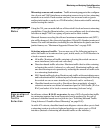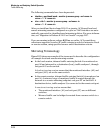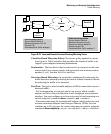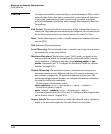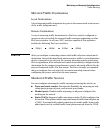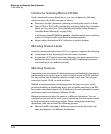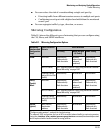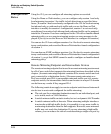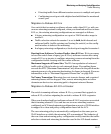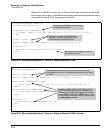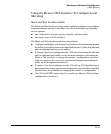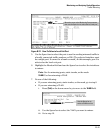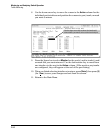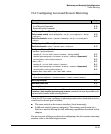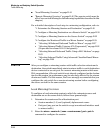
Monitoring and Analyzing Switch Operation
Traffic Mirroring
• Directing traffic from different session sources to multiple exit ports
• Configuring an exit port with a higher bandwidth than the monitored
source port
Migration to Release K.12.xx
On a switch that is running a software release earlier than K.12.xx with one
or more mirroring sessions configured, when you download and boot release
K.12.xx, the existing mirroring configurations are managed as follows:
■ A legacy mirroring configuration on a port or VLAN interface maps to
session 1.
■ Traffic-selection criteria for session 1 is set to both; both inbound and
outbound traffic (traffic entering and leaving the switch) on the config-
ured interface is selected for mirroring.
■ In a legacy mirroring configuration, a local exit port is applied to session 1.
Booting from Software Versions Earlier than K.12.xx: If it is necessary
to boot the switch from a legacy (pre-K.12.xx) software version after using
version K.12.xx or greater to configure mirroring, remove mirroring from the
configuration before booting with the earlier software.
Maximum Supported Frame Size: The IPv4 encapsulation of mirrored
traffic adds a 54-byte header to each mirrored frame. If a resulting frame
exceeds the MTU (Maximum Transmission Unit) allowed in the path from the
mirroring source to the mirroring destination, the frame is dropped. For more
information, refer to “Maximum Supported Frame Size” on page B-92.
No Frame Truncation: Mirroring does not truncate frames, and oversized
mirroring frames will be dropped. Also, remote mirroring does not allow
downstream devices in a mirroring path to fragment mirrored frames.
Migration to Release K.14.01 or Greater
Note If a switch is running software release K.12.xx, you must first upgrade to
release K.13.xx before migrating the switch to release K.14.01 or greater.
When you download and boot software release K.14.01 or greater on a switch
that is running release K.13.xx and has one or more mirroring sessions
configured, an ACL-based mirroring configuration on a port or VLAN interface
is mapped to a class and policy configuration based on the ACL.
The new mirroring policy is automatically configured on the same port or
VLAN interface on which the mirroring ACL was assigned. The behavior of
the new class and mirroring-policy configuration exactly matches the traffic-
selection criteria and mirroring destination used in the ACL-based session.
B-37



